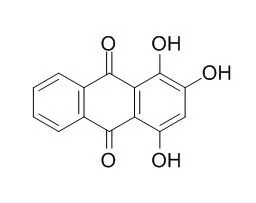| Description: |
Purpurin is one of the natural colorants extracted from madder roots and other Rubiaceae family plants. Purpurin is a novel specific inhibitor of Adipocyte-derived leucine aminopeptidase, it exhibits anti-angiogenic, antifungal, antibiotic, and antioxidative activities. |
| Targets: |
VEGFR | Antifection |
| In vitro: |
| Chin J Nat Med. 2013 Jul;11(4):396-400. | | Effects of lovastatin, clomazone and methyl jasmonate treatment on the accumulation of purpurin and mollugin in cell suspension cultures of Rubia cordifolia.[Pubmed: 23845549] |
METHODS AND RESULTS:
Content determination of Purpurin (AQs) and mollugin (NQs) were carried out using RP-HPLC. The yield of the two compounds was compared with the DMSO-supplied group and the possible mechanism was discussed. Lovastatin treatment increased the yield of Purpurin and mollugin significantly. Clomazone treatment resulted in a remarkable decrease of both compounds. In the MeJA-treated cells, the Purpurin yield increased, meanwhile, the mollugin yield decreased compared with control.
CONCLUSIONS:
The IPP origin of mollugin in R. cordifolia cell suspension cultures was likely from the MEP pathway. To explain the different effects of MeJA on Purpurin and NQs accumulation, studies on the regulation and expression of the genes, especially after prenylation of 1,4-dihydroxy-2-naphthoic acid should be conducted. | | PLoS One. 2012;7(11):e50866. | | Purpurin suppresses Candida albicans biofilm formation and hyphal development.[Pubmed: 23226409] | We have previously demonstrated the novel antifungal activity of Purpurin against Candida fungi.
METHODS AND RESULTS:
In this study, we extended our investigation by examining the in vitro effect of Purpurin on C. albicans morphogenesis and biofilms. The susceptibility of C. albicans biofilms to Purpurin was examined quantitatively by 2,3-bis(2-methoxy-4-nitro-5-sulfo-phenyl)-2H-tetrazolium-5-carboxanilide reduction assay. Hyphal formation and biofilm ultrastructure were examined qualitatively by scanning electron microscopy (SEM). Quantitative reverse transcription-PCR (qRT-PCR) was used to evaluate the expression of hypha-specific genes and hyphal regulator in Purpurin-treated fungal cells. The results showed that, at sub-lethal concentration (3 μg/ml), Purpurin blocked the yeast-to-hypha transition under hypha-inducing conditions. Purpurin also inhibited C. albicans biofilm formation and reduced the metabolic activity of mature biofilms in a concentration-dependent manner. SEM images showed that Purpurin-treated C. albicans biofilms were scanty and exclusively consisted of aggregates of blastospores. qRT-PCR analyses indicated that Purpurin downregulated the expression of hypha-specific genes (ALS3, ECE1, HWP1, HYR1) and the hyphal regulator RAS1. The data strongly suggested that Purpurin suppressed C. albicans morphogenesis and caused distorted biofilm formation.
CONCLUSIONS:
By virtue of the ability to block these two virulence traits in C. albicans, Purpurin may represent a potential candidate that deserves further investigations in the development of antifungal strategies against this notorious human fungal pathogen in vivo. |
|
| In vivo: |
| Psychopharmacology (Berl) . 2020 Mar;237(3):887-899. | | Purpurin exerted antidepressant-like effects on behavior and stress axis reactivity: evidence of serotonergic engagement[Pubmed: 31900524] | | Abstract
Rationale and objectives: Major depression represents a significant public health problem worldwide, and effective regimen is lacking. The present study investigated the antidepressant-like effects of Purpurin, a natural anthraquinone compound from Rubia tinctorum L., and explored the underlying mechanism(s).
Methods: Forced swim test (FST) and tail suspension test (TST) were used to assess antidepressant-like effects of Purpurin in mice. Effects of Purpurin on neuroendocrine responsivity were evaluated at the level of corticosterone and ACTH following acute restraint stress and intracerebroventricular injection of corticotrophin-releasing-factor (CRF). Serotonergic mechanisms underlying Purpurin antidepressant effect were explored using biochemical, neurochemical, and pharmacological paradigms.
Results: Chronic Purpurin treatment exerted in mice dose-dependently antidepressant-like effects on behavior and stress axis reactivity (n = 9-11 per group). The Purpurin-triggered antidepressant-like effects are serotonergically dependent, since Purpurin-treated mice showed escalated levels of brain serotonin and suppressed monoamine oxidase (MAO) activity (n = 8-11 per group). Consistently, chemical depletion of brain serotonin by p-chlorophenylalanine (PCPA) abolished the antidepressant-like effects of Purpurin on behavior and stress axis responsivity (n = 9-10 per group). Moreover, the antidepressant effect by Purpurin was preferentially counteracted by 1A-selective 5-HT receptor antagonist WAY-100635, but potentiated by 1A-selective agonist 8-OH-DPAT and sub-effective dose of serotonergic antidepressant fluoxetine (n = 9-11 per group), suggesting a crucial role for 5-HT1A related serotonergic system in mediating such Purpurin antidepressant effect.
Conclusion: We have revealed the antidepressant-like effects of Purpurin on both behavior and stress axis reactivity in mice, with serotonergic system that preferentially couples with 5-HT1A receptors being critically engaged.
Keywords: Antidepressant-like effect; Purpurin; Serotonin; Stress. |
|






 Cell. 2018 Jan 11;172(1-2):249-261.e12. doi: 10.1016/j.cell.2017.12.019.IF=36.216(2019)
Cell. 2018 Jan 11;172(1-2):249-261.e12. doi: 10.1016/j.cell.2017.12.019.IF=36.216(2019) Cell Metab. 2020 Mar 3;31(3):534-548.e5. doi: 10.1016/j.cmet.2020.01.002.IF=22.415(2019)
Cell Metab. 2020 Mar 3;31(3):534-548.e5. doi: 10.1016/j.cmet.2020.01.002.IF=22.415(2019) Mol Cell. 2017 Nov 16;68(4):673-685.e6. doi: 10.1016/j.molcel.2017.10.022.IF=14.548(2019)
Mol Cell. 2017 Nov 16;68(4):673-685.e6. doi: 10.1016/j.molcel.2017.10.022.IF=14.548(2019)